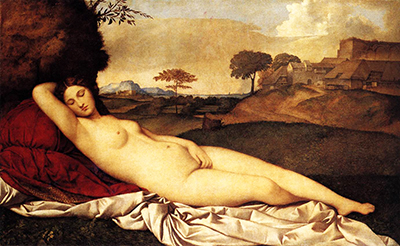Giorgione, renowned Venetian artist of the 16 th century, was one of the most influential masters of the renaissance. The Sleeping Venus, also known as The Dresden Venus, is a world-famous treasure which was left unfinished on his death in 1510.
The painting was later completed by his great friend and admirer, Titian. It is unclear, however, as to how much of the painting was original, therefore, the actual amount of the painting that can be credited to Giorgione if still debated today. The Sleeping Venus was the first reclining female nude painted by a western artist, and as such is yet another seminal work by this great master. Today, it can be found in the Gemäldegalerie Alte Meister in Dresden, Germany.
The Sleeping Venus depicts a life-sized figure of a reclining female nude lying on sheets and resting on a large pillow. A nude would have been an unusual topic for a painting in Giorgione’s time, far less a life-sized one, which would have meant that this work was quite cutting-edge in 16th century Venice. The landscape in the background mirrors the contours of the Goddess. In addition, the warm and subtle colouring of both the figure and the surroundings blend the two together creating a seamless unity.
The woman has her left hand raised over her head, while her right hand shields her groin. The pervading mood of the painting is one of relaxed eroticism, leaving the viewer with a profound sense that this is a natural state which blends with nature herself.
Giorgione and Titian were founding members of the renaissance's famous Venetian School and great admirers of each other's works. They shared similar styles, philosophies and techniques and as a result, it can be very difficult to tell their work apart. Although it is generally considered to be an un- commissioned work, it is possible that The Sleeping Venus, was commissioned by Marcantonio Michiel c.1521 as a wedding gift for his wife. However, it is widely considered to be the most perfect rendering of the Goddess created, even to this day.
While critics debate how much of the painting can be attributed to Giorgione, it is commonly understood that the figure herself was completed before his death and it was the landscape and some of the coverings that were completed by Titian. X-rays have revealed many interesting details within the work that may provide clarity as to which elements were created by which artist. For example, it is revealed that the Venus may originally have had her head in profile, meaning that the figure would have almost been in the exact attitude of Titian’s own, later composition, Pardo Venus.
Some would surmise from this, that in fact, Titian is responsible for most of the painting, but it could also be argued that it is actually more evidence of Titian’s great admiration for the master, Giorgione. Alternatively, it could have been Giorgione himself who decided on the change of attitude. Additionally, it is clear that the colours used in the sheets and pillows have been changed from gold to a more silvery palette. The new tones are widely considered a signature of Titian; therefore, it is believed that they were completed by him after Giorgione's death. Sadly, x-rays also revealed that there was, originally, a cupid at Venus' feet which was subsequently removed during clumsy restoration in the 19th century.
Giorgione was a renowned advocate of the human form. His paintings were devoted to the portrayal of natural shape and beauty, and The Sleeping Venus is perhaps the most ideal example of his skill and genius. Through his clever use of colour and blending techniques, he produced a subtlety within the painting evocative of feminine beauty and erotic pleasure. The figure becomes almost luminous by his gifted use of light, implying emotion and depth.
The Goddess' reclining posture, coupled with her hand positioning, translates an exquisite recollection of love rather than the act itself. It is only through the skilful use of colour and shade, and the subject matter, that we understand exactly what the artist is saying. It could so easily have had a baser meaning had it not been for the attending cupid signifying Venus, Goddess of love. The beautiful landscape surrounding Venus is of course a master class in the use of colour and mood in the hands of Giorgione. It becomes an integral part of the painting itself, blending so completely with Venus that we understand how very natural the state of love is in the mind of the artist.
Giorgione was a hugely influential figure for all of his innovations and his remarkable use of colour. Indeed, the great biographer Vasari grouped him with Da Vinci and Michelangelo when he spoke about the most inspiring artists of the renaissance. However, one only has to look at the work of his fellow artists to see the huge impact his, The Sleeping Venus had on the world of art, both in the use of colour and in composition. Clearly Titian’s own Venus of Urbino and Pardo Venus were very must inspired by his friend’s work, but also later artists such as Velazquez and Goya, who subsequently chose reclining nudes as their subject to great effect. Giorgione's great skill even went on centuries later to inspire the young Manet in 1863 in his magnificent Olympia.




